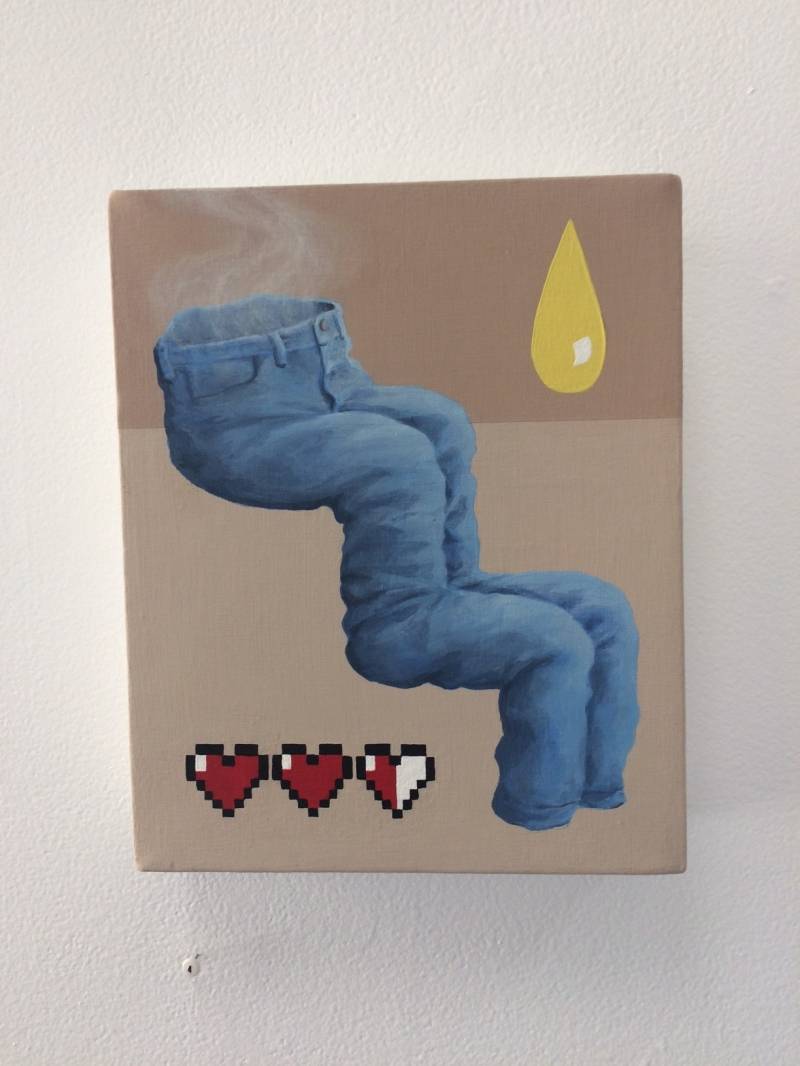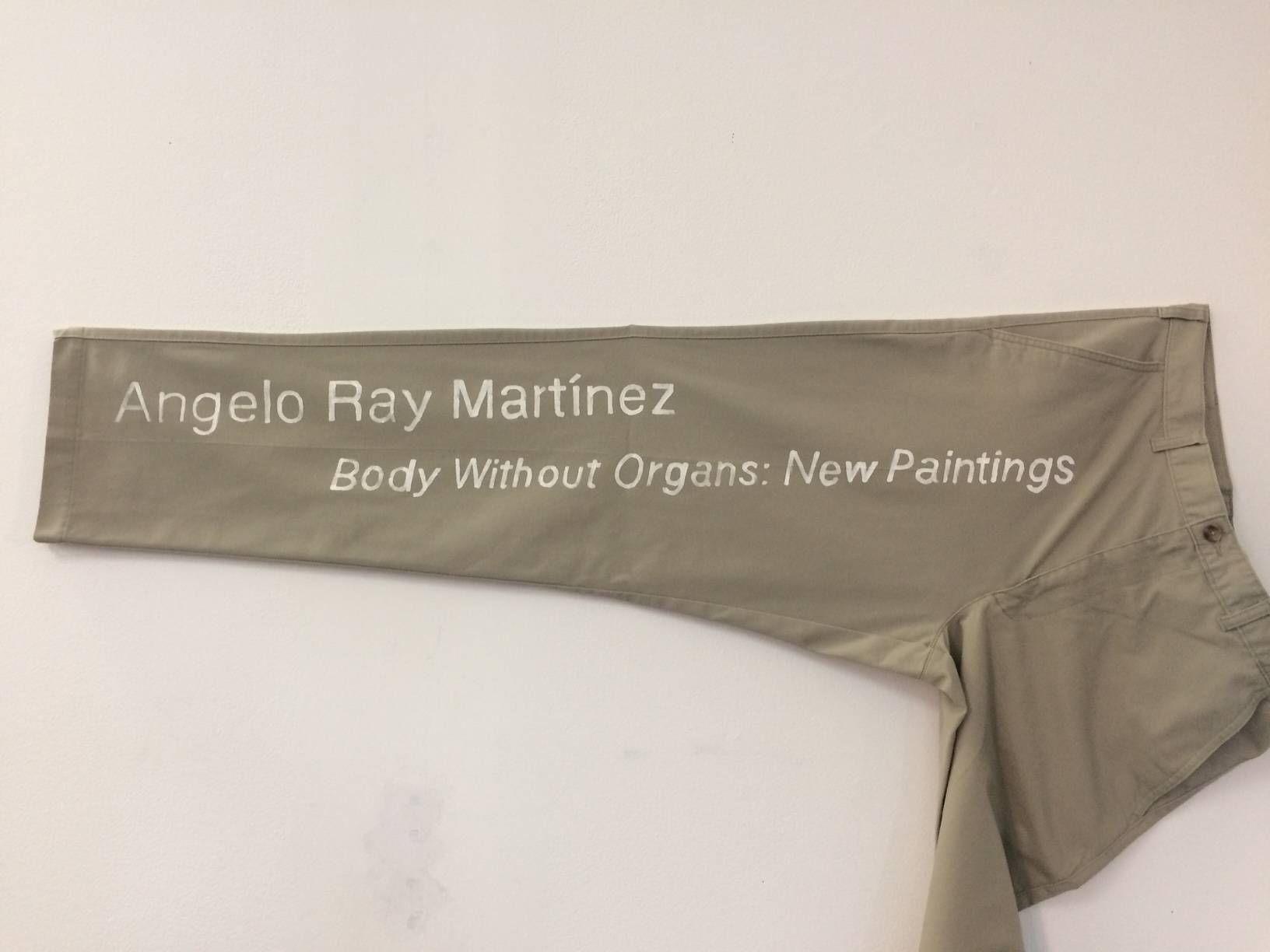Body Without Organs, which opened at the Independent Media Center Gallery on November 11th, is artist Angelo Ray Martìnez’s first exhibition since graduating from the University of Illinois at Champaign-Urbana’s MFA program in May 2016. Martìnez recently moved to South Bend, Indiana with partner and fellow UIUC MFA alum Melonie Mulkey, and now teaches as an instructional assistant professor at Illinois State University in Bloomington. Though his work has appeared at the Lightbox Gallery, Link Gallery, Figure One and the Boneyard Arts Festival, this is his first solo exhibition. Body Without Organs features six paintings, five acrylic on canvas and one on an old television set, in addition to a digital video installation. These paintings repeat and remix a group of pop culture images including tattoo art, 8-bit video game imagery and pants, to explore issues of hybridity, identity and consumer culture in a post-digital age.

IMC Gallery
The gallery space is small, and the paintings themselves —which have clear roots in sculpture— are deceptively simple in composition. But a closer investigation into links between the paintings reveals that this playful exhibition is also a thematically dense one. I talked with Martìnez about his inspirations and artistic process in creating Body Without Organs.
SP: What are your sources of inspiration for this group of pieces?
Angelo Martìnez: I incorporate a lot of 8-bit video game imagery, tattoo images, and articles of clothing. I try to synthesize these three different aspects of culture to talk about my own negotiations of identity but also to open it up to larger discussions of identity, whether individual or cultural. In my graduate program, I started off as a painter and then went sculptural. I would fill pants or dip them in concrete (see Caryatid, 2014). These paintings are extensions of some of those earlier sculptural works.
SP: Could you explain one of the paintings in a little more detail? How about “Column I”?
Martìnez: Both “Column I” and “Column II” are self-portraits in a certain way. When I first came into the art world I was an aspiring tattoo artist. My father is a construction worker, and I grew up on construction sites. The fine art world always seemed like this inaccessible place to me. “Column I” is about fluidity. Denim itself is very fluid. It relates to early Americana: Levi Strauss, workers’ jeans, working class blue collar labor. But denim can also be high fashion.

“Column I” by Angelo Martinez
Martìnez: I identify as Mexican-American. I grew up in southwest Colorado, and Hispanic families were encouraged not to speak Spanish. So I didn’t grow up speaking Spanish, but I would always have people expecting me to speak Spanish. At the same time, I would meet people who identified more with Mexican culture. There are a lot of these conflicts of identity. I think I was also using denim as a symbol of that hybridity to some degree.
Originally, I thought of the pink marks that are above the pants as extensions of the identity of the painter. But then I started to think of them as encoding more significant or personal values or histories. In a lot of my work I’m thinking about what it’s like to be a post-digital painter. The pink marks are like a row of binary code, where you don’t understand what it means, but that doesn’t negate its significance. It’s the information about your own experiences that other people might not know.
It’s also about how we homogenize skin tones. I looked at my hand when I was painting…from the fingernail to a dark, rosy green tint inside of the veins. Even in a small part of the body there are so many colors, but we simplify or reduce it.
SP: How about the title?
Martìnez: I was thinking about it as an architectural column. It invokes an upright structure and invites questioning about what kinds of values, ideas, or institutions are being supported by this body. When I teach, I think a lot about what types of values I’m supporting.
SP: A couple of the paintings have two of the same object, like “Peculiarity”. How come?
Martìnez: Another aspect of being a post-digital consciousness is the easy reproducibility of information. For a lot of my art I’ll just find objects online and I’ll copy and paste in Photoshop. I’m also thinking about how we express our individuality through the reproducible forms that we collect. For instance a tattoo rose, which traditionally would have been something in a tattoo shop. Customers come and pick out that rose, and they use that to express something about themselves even though it is a very traditional tattoo. Some people think I’m criticizing consumer culture, which I’m not necessarily intending.

“Peculiarity” by Angelo Martìnez
SP: What is the trajectory of your work since you started your MFA?
Martìnez: When I first got into the MFA program, I was thinking sculpturally because I wanted to transform how we think of everyday objects. Then I realized it was more the image of the object that I was fascinated with. Part of it has to do with the way that paint pretends to be the object but it never really is; I enjoy how paint can deceive us in a lot of ways. But a lot of the work I make is influenced by my exploration of sculpture. When I went into the grad program I thought, “I’ll figure everything out in grad school.” But for me, a tremendous period of growth has occurred in the past four or five months. I had a lot of different ideas in my thesis exhibition which was last May, and I’m still digging deeper into those ideas.
SP: Do you ever think about getting back into tattooing?
Martìnez: I have not done actual tattoos, though I have quite a few friends who are tattoo artists. Before I started my undergrad in Colorado I was working on getting a tattoo apprenticeship. That’s when I had an influential professor who helped shift my career path in a lot of ways. I always hoped that I would learn to tattoo after I finished school. Only recently did I come to terms with the fact that I will never get to tattoo. But in the grad program I was actually using a tattoo gun on a lot of wooden legs. A lot of the stuff I’m drawn to is traditional or neo-traditional.
SP: I know that the phrase “body without organs” comes from the French philosopher Gilles Deleuze. Why did you choose it for your exhibition title?
Martìnez: It’s so poetic! I had my students read a particular text that talks about the concept of the “rhizome.” As I was mentioning, my teaching always influences my work. I liked the idea of random connections and bleeding from different spaces which may not be directly connected. I’m always trying to find the connection between unrelated subjects: tattoo imagery, jeans or pants, video games, etc. And then my professor Patrick Hammie would say “you’re making work about the body, but it’s never there.” I found this phrasing so poetic and beautiful, this idea of a desensualized body without organs.
I highly recommend stopping by Body Without Organs, which is open until November 30th at the IMC Gallery. You can find out more about Angelo Ray Martìnez’s earlier work at angeloraymartinez.com, and you can follow him on instagram @angeloraymartinez.









